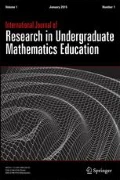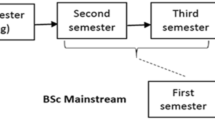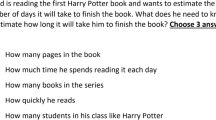Abstract
Facing increased pressure to improve retention and graduation rates, engineering departments are increasingly scrutinizing whether they are getting their desired outcomes from core mathematics coursework. Since mathematics courses are a significant source of attrition and many engineering faculty are unhappy with students’ mathematical abilities, more engineering departments are increasingly looking at drastic options of taking students out of mathematics courses and teaching students mathematics themselves. To mitigate this trend, it may be valuable to better understand what engineering faculty hope students learn from their mathematics coursework. When engineering faculty explain why they require these high-failure prerequisites, many claim that “mathematical maturity”, not calculus skill, is the desired outcome of completing the core math sequence of courses. To better understand what engineering faculty mean by “mathematical maturity”, we conducted a qualitative thematic analysis of how 27 engineering faculty members define “mathematical maturity”. We found that these engineering faculty believed that the mathematically mature student would have strong mathematical modeling skills supported by the ability to extract meaning from symbols and the ability to use computational tools as needed. Faculty frequently lamented that students had underdeveloped epistemic beliefs that undermined their modeling skills, thinking that mathematics is unrelated to the real world and has little practical value. They attributed these dysfunctional epistemic beliefs to their perception that mathematics is too often taught without genuine physical context and realistic examples. We suggest potential avenues for reform that will allow mathematics departments to better serve their client departments in engineering and thus retain control of their courses.

Similar content being viewed by others
Notes
The AC T is a standardized exam in the United States. High scores on the math section of the AC T are required for admission to prestigious engineering universities in the United States.
References
Ahmad, J., Appleby, J., & Edwards, P.. (2001). Engineering mathematics should be taught by engineers! In N. Gordon (Ed.), Proceedings of Undergraduate Mathematics Teaching Conference (pp. 32–40). Birmingham, Alabama: University of Birmingham.
Alpers, B. (2017). The mathematical modelling competencies required for solving engineering statics assignments. In G.A. Stillman, W. Blum, & G. Kaiser (Eds.), Mathematical modelling and applications: Crossing and researching boundaries in mathematics education, 189–99. Retrieved from https://www.springer.com/gp/book/9783319629674.
Alpers, B., Demlova, M., Fant, C.-H., Gustafsson, T., Lawson, D., Mustoe, L., & Velichova, D. (2013). A framework for mathematics curricula in engineering education: A report of the mathematics working group. Brussels: European Society for Engineering Education (SEFI).
Arcavi, A. (2005). Developing and using symbol sense in mathematics. For the Learning of Mathematics, 25(2), 42–48.
Bardini, C., & Pierce, R. (2015). Assumed mathematics knowledge: The challenge of symbols. International Journal of Innovation in Science and. Mathematics Education, 23(1), 1–9.
Barquero, B., Bosch, M., & Gascón, J. (2011). 'Applicationism' as the dominant epistemology at university level. In M. Pytlak, T. Rowland, & E. Swoboda (Eds.), Proceedings of the Seventh Congress of the European Society for Research in Mathematics Education (pp. 1938–1948). Rzeszów: University of Rzeszów.
Braun, V., & Clarke, V. (2006). Using thematic analysis in psychology. Qualitative Research in Psychology, 3(2), 77–101.
Budny, D., Bjedov, G., & LeBold, W. (1997). Assessment of the impact of the freshman engineering courses. EP Innovations (Ed), Proceedings of Frontiers in Education 1997 27th Annual Conference: Teaching and Learning in an Era of Change (pp. 1100–1106). Pittsburgh, Pennsylvania: University of Pittsburgh.
Cardella, M. (2008). Which mathematics should we teach engineering students? An empirically-grounded case for mathematical thinking. Teaching Mathematics and Its Applications, 27(3), 150–159.
Clark, R., Feldon, D., Merrienboer, J. V., Yates, K., & Earl, S. (2008). Cognitive task analysis. In J. Spector, M. Merrill, J. van Merrienboer, & M. Driscol (Eds.), Handbook of research on educational communications and technology (3rd ed., pp. 1801–1856). Mahwah: Erlbaum.
Dunn, J. W., & Barbanel, J. (2000). One model for an integrated math/physics course focusing on electricity and magnetism and related calculus topics. American Journal of Physics, 68(8), 749.
Eilam, B., & Poyas, Y. (2008). Learning with multiple representations: Extending multimedia learning beyond the lab. Learning and Instruction, 18(4), 368–378.
Elby, A. (2001). Helping physics students learn how to learn. American Journal of Physics, 69(7), 54–64.
Engelbrecht, J., Bergsten, C., & Kagesten, O. (2012). Conceptual and procedural approaches to mathematics in the engineering curriculum: Student conceptions and performance. Journal of Engineering Education, 101(1), 138–162.
Ferguson, L. (2012). Understanding calculus beyond computations: A descriptive study of the parallel meanings and expectations of teachers and users of calculus. (doctoral dissertation). Indiana University, Bloomington, Indiana.
Firouzian, S., Ismail, Z., Rahman, R. A., Yusof, Y. M., Kashefi, H., & Firouzian, F. (2014). Mathematical competency of engineers and engineering students. In J. Guerrero (Ed.), Proceedings of 2014 International Conference on Teaching and Learning in Computing and Engineering, LATICE 2014 (pp. 216–219). Kuching, Sarawak, Malaysia: IEEE.
Froyd, J. E., & Ohland, M. W. (2005). Integrated engineering curricula. Journal of Engineering Education, 94(1), 147–164.
Gainsburg, J. (2006). The mathematical modeling of structural engineers. Mathematical Thinking and Learning, 8(1), 3–36.
Gainsburg, J. (2007). The mathematical disposition of structural engineers. Journal for Research in Mathematics Education, 38(5), 477–506.
Gainsburg, J. (2012). Developing skeptical reverence for mathematics. Paper presented at 2012 ASEE Annual Conference & Exposition, San Antonio, Texas.
Ganter, S. L., & Barker, W. (2004). A collective vision: Voices of the partner disciplines. Mathematical Association of America. Washington, DC: MAA.
Gardner, J., Pyke, P., Belcheir, M., & Schrader, C. (2007). Testing our assumptions: Mathematics preparation and its role in engineering student success. ASEE Annual Conference. Honolulu, Hawaii.
Goold, E., & Devitt, F. (2014). Mathematics in engineering practice: Tacit trumps tangible. In B. Williams, J. Figueiredo, & J. Trevelyan (Eds.), Engineering practice in a global context (pp. 245–264). London: Taylor and Francis.
Guba, E. G., & Lincoln, Y. S. (1994). Competing paradigms in qualitative research. In N. K. Denzin & Y. S. Lincoln (Eds.), Handbook of qualitative research (pp. 105–117). Thousand Oaks: Sage.
Gupta, A., & Elby, A. (2011). Beyond epistemological deficits: Dynamic explanations of engineering students’ difficulties with mathematical sense-making. International Journal of Science Education, 33(18), 2463–2488.
Hammer, D. (1994) Epistemological beliefs in introductory physics. Cognition and Instruction, 12(2), 151–183.
Hamilton, E. (2008). Model-Eliciting Activities (MEAs) as a Bridge between Engineering Education Research and Mathematics Education Research. Advances in Engineering Education, 1(2), n2.
Hamilton, E., Lesh, R., Lester, F., & Brilleslyper, M. (2008). Model-Eliciting Activities ( MEAs ) as a bridge between engineering education research and mathematics Department of Mathematical Sciences. Advances in Engineering Education, 1(2), 1–25.
Hoit, M., & Ohland, M. (1998). The impact of a discipline-based introduction to engineering course on improving retention. Journal of Engineering Education, 87(1), 79–85.
Janowski, G., Lalor, M., & Moore, H. (2008). New look at upper-level mathematics needs in engineering courses at the University of Alabama at Birmingham. ASEE Annual Conference. Pittsburgh, Pennsylvania.
Jones, S. R., Lim, Y., & Chandler, K. R. (2016). Teaching integration: How certain instructional moves may undermine the potential conceptual value of the Riemann sum and the Riemann integral. International Journal of Science and Mathematics Education, 15(6), 1075–1095.
Klingbeil, N. W., & Bourne, A. (2014). The Wright state model for engineering mathematics education: A longitudinal study of student perception data. In 121st American Society for Engineering Education Conference. Indianapolis, Indiana.
Kuo, E. (2013). More than just “plug-and-chug”: Exploring how physics students make sense with equations. (doctoral dissertation). University of Maryland, College Park, Maryland.
Landis, J. R., & Koch, G. G. (1997). An application of hierarchical kappa-type statistics in the assessment of majority agreement among multiple observers. Biometrics, 33(2), 363–374.
Langdon, D., Beede, D., & Doms, M. (2011). STEM: Good jobs now and for the future. Economics and Statistics Administration Issue Brief, 3(11), 1–10.
Lesh, R., & Harel, G. (2003). Problem solving, modeling, and local conceptual development. Mathematical Thinking and Learning, 5(2–3), 157–189.
Maltese, A. V., & Tai, R. H. (2011). Pipeline persistence: Examining the association of educational experiences with earned degrees in STEM among U.S. students. Science Education, 95(5), 877–907.
Maxwell, J. A. (2010). Using numbers in qualitative research. Qualitative Inquiry, 16(6), 475–482.
Moore, H. (2012). Using projects to stimulate learning in mathematics and engineering mathematics courses. Proceedings of the 2012 ASEE Annual Conference and Exposition.
Moore, T. J., Miller, R. L., Lesh, R. a., Stohlmann, M. S., & Kim, Y. R. (2013). Modeling in engineering: The role of representational fluency in students’ conceptual understanding. Journal of Engineering Education, 102(1), 141–178.
Muis, K. R. (2004). Personal epistemology and mathematics: A critical review and synthesis of research. Review of Educational Research, 74(3), 317–377.
Niss, M., & Højgaard, T. (2011). Competencies and mathematical learning: Ideas and inspiration for the development of mathematics teaching and learning in Denmark. Roskilde University, Roskilde, Denmark.
O’Connor, K., Peck, F. A., Cafarella, J., Sullivan, J. F., Ennis, T. D., Myers, B. A., & Louie, B. (2015). Constructing “calculus readiness”: Struggling for legitimacy in a diversity- promoting undergraduate engineering program. ASEE Annual Conference Seattle, Washington.
Raman, M. (2002). Coordinating informal and formal aspects of mathematics: Student behavior and textbook messages. Journal of Mathematical Behavior, 21(2), 135–150.
Redish, E. F., & Smith, K. a. (2008). Looking beyond content: Skill development for engineers. Journal of Engineering Education, 97(3), 295–307.
Rota, G.-C. (1997). Ten lessons I wish I had learned before I started teaching differential equations. In Mathematical Association of America. Retrieved from http://www.ega-math.narod.ru/Tasks/GCRota.htm.
Santos, A. G. D., & Thomas, M. O. J. (2003). Representational ability and understanding of derivative. In N.A. Pateman (Ed.), Proceedings of the 27th Conference of the International Group for the Psychology of Mathematics Education Held Jointly with the 25th Conference of PME-NA (pp. 325–332). Honolulu, Hawaii: International Group for the Psychology of Mathematics Education.
Schoenfeld, A. H. (1992). Learning to think mathematically: Problem solving, metacognition, and sense making in mathematics. In D. Grouws (Ed.), Handbook for research on mathematics teaching and learning (1st ed.). New York: Macmillan.
Schommer, M. (1990). Effects of beliefs about the nature of knowledge on comprehension. Journal of Educational Psychology, 82(3), 498–504.
Schommer, M., Crouse, A., & Rhodes, N. (1992). Epistemological beliefs and mathematical text comprehension: Believing it is simple does not make it so. Journal of Educational Psychology, 84(4), 435–443.
Steen, L. A. (1983). Developing mathematical maturity. In A. Ralston (Ed.), The future of college mathematics (pp. 99–110). Williamstown: Springer-Verlag New York.
Stewart, J. (2015). Calculus: Early transcendentals (8th ed.). Pacific Grove: Brooks/Cole Pub.
Svinicki, M. D. (2004). Learning and motivation in the postsecondary classroom. San Francisco: Anker.
Szydlik, J. E. (2000). Mathematical beliefs and conceptual understanding of the limit of a function. Journal for Research in Mathematics Education, 31(3), 258–276.
Thornton, K., Nola, S., Garcia, R. E., Asia, M., & Olson, G. B. (2009). Computational materials science and engineering education: A survey of trends and needs. The Journal of The Minerals, Metals & Materials Society, 61(10), 12–17.
Torigoe, E., & Gladding, G. (2007). Symbols: Weapons of math destruction. In L. Barbato (Ed.), Proceedings of Physics Education Research Conference 2007 (pp. 200–203). Greensboro, NC: American Institute of Physics.
Trautwein, U., & Lüdtke, O. (2007). Epistemological beliefs, school achievement, and college major: A large-scale longitudinal study on the impact of certainty beliefs. Contemporary Educational Psychology, 32(3), 348–366.
van der Wal, N. J., Bakker, A., & Drijvers, P. (2017). Which techno-mathematical literacies are essential for future engineers? International Journal of Science and Mathematics Education, 15(1), 87–104.
Van Dyken, J., Benson, L., & Gerard, P. (2015). Persistence in engineering: Does initial mathematics course matter? ASEE Annual Conference and Exposition. Indianapolis, Indiana.
Vazquez, A. R. (2010). Mathematics in the training of engineers: An approach from two different perspectives. In Educational Interfaces between Mathematics and Industry 2010 (pp. 533–540). Lisbon, Portugal.
Zawojewski, J. S., Diefes-Dux, A. H., & Bowman, K. J. (2004). A framework for posing open-ended engineering problems: Modeleliciting activities. F1A-3.
Zawojewski, J. S., Diefes-Dux, A. H., & Bowman, K. J. (2008). Models and modeling in engineering education. Rotterdam: Sense.
Acknowledgements
This work was supported by the National Science Foundation under grant EEC 1544388. The opinions, findings, and conclusions do not necessarily reflect the views of the National Science Foundation or the author’s institution.
Author information
Authors and Affiliations
Corresponding author
Additional information
Publisher’s Note
Springer Nature remains neutral with regard to jurisdictional claims in published maps and institutional affiliations.
Appendix: Interview Protocol
Appendix: Interview Protocol
The interview protocol is a semi-structured interview with a set of main questions and samples of follow-up questions depending on how the interviewee responds.
Introductory Questions
-
1.
What engineering courses do you teach?
-
a.
How often do you teach these courses?
-
b.
Why do you teach these particular courses?
-
a.
-
2.
Have you been an engineer in industry before your present career in academia?
-
a.
What did you do? What mathematics did you use on the job?
-
a.
-
3.
What are the prerequisite math courses for the courses you teach?
-
a.
In what ways does students’ performance in each course you teach depend on their performance in the mathematics prerequisites?
-
b.
How do you perceive the content of the courses you teach build on the content of the prerequisite courses?
-
c.
In the courses you teach, how would you describe the importance of mathematics?
-
a.
Primary Questions
-
4.
What is your general perception of the mathematical preparedness of the students rising up to your course?
-
a.
How many lectures do you spend on purely mathematical review for your course?
-
b.
Does this vary by semester?
-
c.
How do you interpret students’ lack of preparation?
-
d.
What part do the instructors of the prerequisite courses play?
-
e.
What part does the curriculum itself play?
-
a.
-
5.
What types of attitudes toward mathematics in Engineering do you perceive in your students? How do those attitudes impede students’ learning?
-
a.
Do students perceive the “real life” applications of the math they have been taught? Can they connect math to application? The engineering uses?
-
b.
What do you do to alter this attitude?
-
c.
Do you consider attitudes about learning to be key goals?
-
a.
-
6.
Is the math students use in your class genuine to the experience of engineering (in your experience in academia/industry)?
-
a.
Do you assign problems that have multiple correct solutions? Solutions that aren’t immediately apparent?
-
b.
How many minutes do the longest problems take an average students to solve?
-
c.
How do your students think about models, critically or hegemonically? Does this improve after taking your course?
-
a.
Additional Questions
-
7.
What do you think should be the relationship between the engineering curriculum and mathematics curriculum? How well are the current curricula meeting your expectations and needs?
-
a.
What do you think about the choice of content and order of content presentation?
-
b.
Do students remember/transfer what they have learned in math?
-
c.
Are math courses a form of mental exercise for engineers but not directly applicable? Just a form of general education?
-
a.
-
8.
Do you believe that some mathematics topics or skills are taught better by mathematics faculty and some are taught better by engineering faculty? Why or Why not?
-
a.
For example, electrical engineering makes much more extensive use of Laplace transforms, but they are still covered in the standard Differential Equations class
-
a.
-
9.
What emphasis do you put on derivations in your course? Do you think they are important for future practicing engineers? For future engineering researchers?
-
10.
What specific mathematical knowledge must students have mastered to do well in your course?
-
a.
Is it things like integration by parts, or how to define variables, or “what is a scalar?”
-
a.
-
11.
What mathematical knowledge do you think students should have mastered but is not taught in prerequisite calculus sequence course (dimensional analysis, name that object game, extreme case analysis, etc)?
-
12.
Describe your students’ skills at manipulating notation or working with symbols abstractly.
-
a.
Do you encourage graphical/intuitive methods over analytic/formal methods?
-
b.
Do you encourage estimation (over calculation) in your class?
-
c.
Do they think they can create their own methods or are they beholden to the formula sheet?
-
a.
Rights and permissions
About this article
Cite this article
Faulkner, B., Earl, K. & Herman, G. Mathematical Maturity for Engineering Students. Int. J. Res. Undergrad. Math. Ed. 5, 97–128 (2019). https://doi.org/10.1007/s40753-019-00083-8
Published:
Issue Date:
DOI: https://doi.org/10.1007/s40753-019-00083-8




